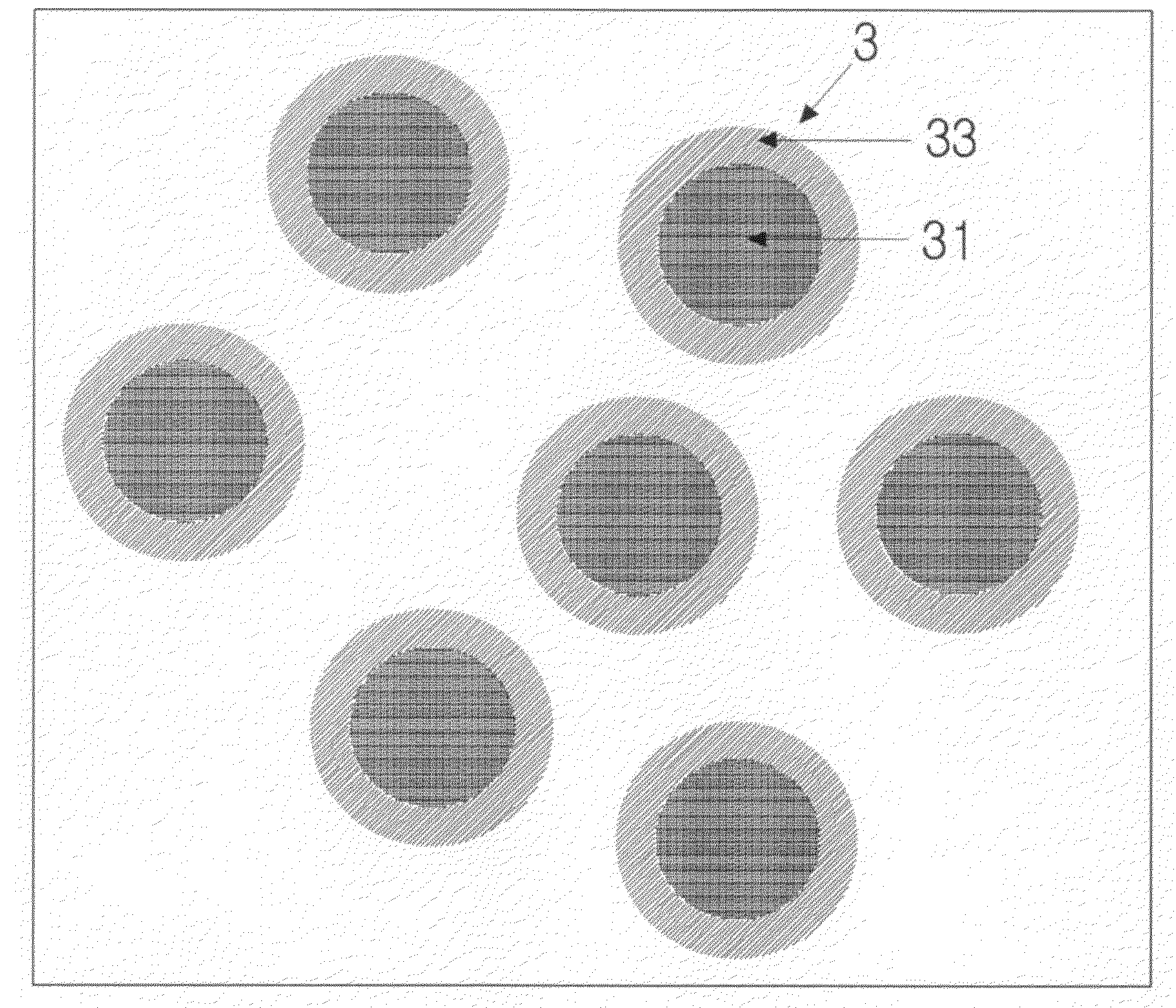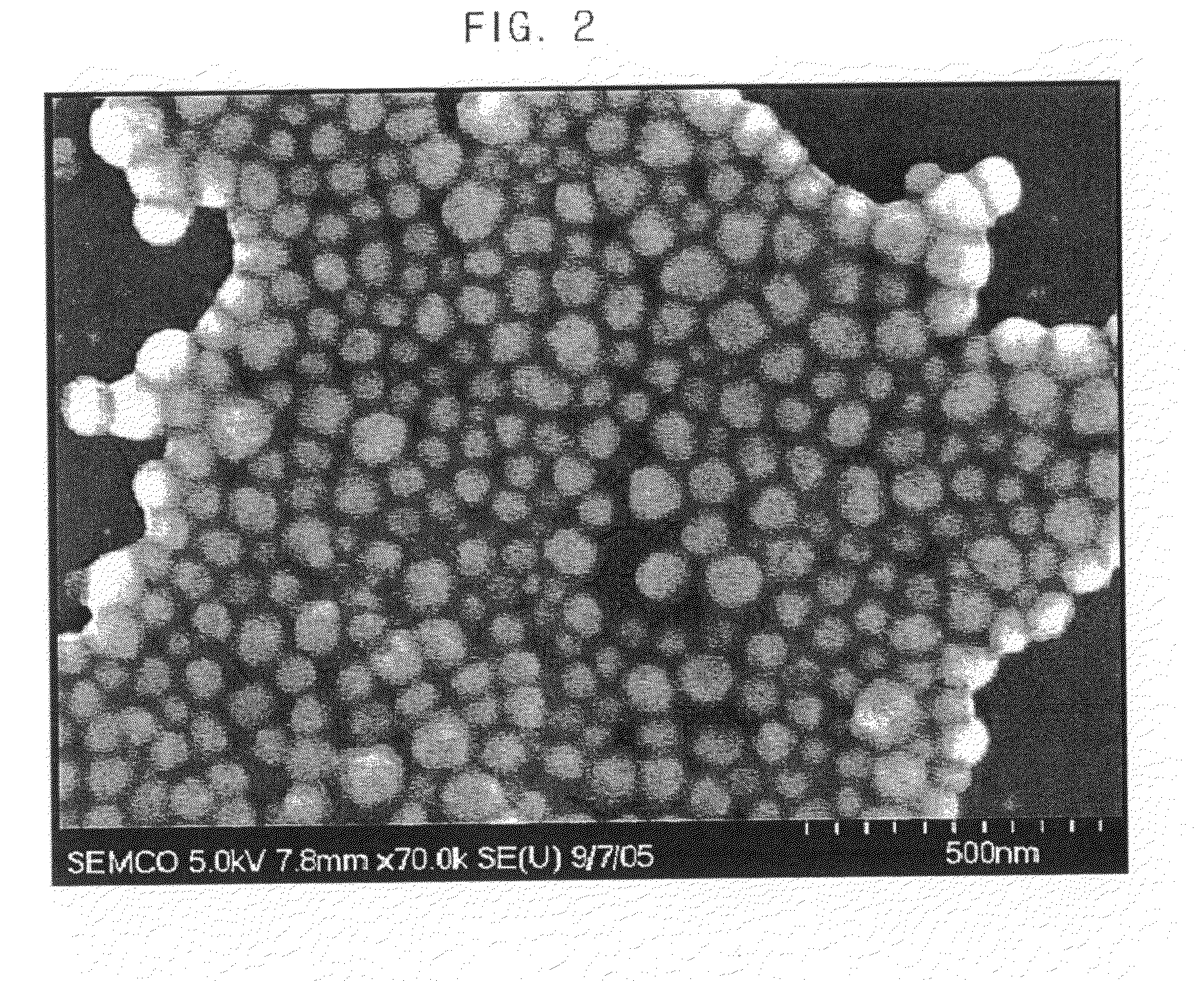Core-shell structure metal nanoparticles and its manufacturing method thereof
a core-shell structure and metal nanoparticle technology, applied in the direction of cable/conductor manufacturing, non-conductive materials with dispersed conductive materials, inks, etc., can solve the problems of high cost, limited synthesizing small-sized metal nanoparticles of 30 nm or less, and high cost, so as to prevent oxidization of copper and increase copper content , the effect of economical efficiency
- Summary
- Abstract
- Description
- Claims
- Application Information
AI Technical Summary
Benefits of technology
Problems solved by technology
Method used
Image
Examples
example 1
[0067]Oleylamine 100 g, copper acetylacetonate(C5H7CuO2) 7 g and ascorbic acid 5 g were put into a round flask equipped with a condenser and heated to 70° C. for 1 hour. After then, the temperature was raised to 250° C. by a rate of 5° C. / min, and the reaction solution was reacted for 30 min at 250° C. After the reaction solution was cooled to 150° C. by air-cooling, 2 g of Ag dodecanate was added and then the temperature was raised to 250° C. by a rate of 5° C. / min, and the reaction solution was reacted for 30 min at 230° C. After the reaction completed, 300 ml of methanol was added and the nanoparticles were precipitated. These precipitates were washed with methanol more than 3 times and dried at 45° C. in a drying oven.
[0068]FIG. 2 is a SEM photo of the metal nanoparticles produced according to this procedure, FIG. 3 is particle distribution of the metal nanoparticles produced according to example 1, FIG. 4 is also a TEM photo of the metal nanoparticles produced according to exam...
example 2
[0069]Oleylamine 50 g, 1-octadecene 50 g, copper acetylacetonate(C5H7CuO2) 20 g and ascorbic acid 15 g were put into a round flask equipped with a condenser and heated to 70° C. for 1 hour. After then, the temperature was raised to 110° C. by a rate of 5° C. / min, and the reaction solution was reacted for 1 hour. After the solution was cooled to 50° C. by air-cooling, 7 g of Ag dodecanate was added and then the temperature was raised to 110° C. by a rate of 5° C. / min, and the reaction solution was reacted for 1 hour at 110° C. After the reaction completed, 300 ml of methanol was added and the nanoparticles were precipitated. These precipitates were washed with methanol more than 3 times and dried at 45° C. in a drying oven.
example 3
[0070]Oleylamine 50 g, xylene 50 g, copper acetylacetonate(C5H7CuO2) 20 g and ascorbic acid 15 g were put into a round flask equipped with a condenser and heated to 70° C. for 1 hour. After then, the temperature was raised to 250° C. by a rate of 5° C. / min, and the reaction solution was reacted for 30 min at 250° C. After the reaction solution was cooled to 50° C. by air-cooling, 7 g of Ag dodecanate was added and then the temperature was raised to 250° C. by a rate of 5° C. / min, and the reaction solution was reacted for 30 min at 250° C. After the reaction completed, 300 ml of methanol was added and the nanoparticles were precipitated. These nanopricipitates were washed with methanol more than 3 times and dried at 45° C. in a drying oven.
PUM
| Property | Measurement | Unit |
|---|---|---|
| size | aaaaa | aaaaa |
| diameter | aaaaa | aaaaa |
| diameter | aaaaa | aaaaa |
Abstract
Description
Claims
Application Information
 Login to View More
Login to View More - R&D
- Intellectual Property
- Life Sciences
- Materials
- Tech Scout
- Unparalleled Data Quality
- Higher Quality Content
- 60% Fewer Hallucinations
Browse by: Latest US Patents, China's latest patents, Technical Efficacy Thesaurus, Application Domain, Technology Topic, Popular Technical Reports.
© 2025 PatSnap. All rights reserved.Legal|Privacy policy|Modern Slavery Act Transparency Statement|Sitemap|About US| Contact US: help@patsnap.com



